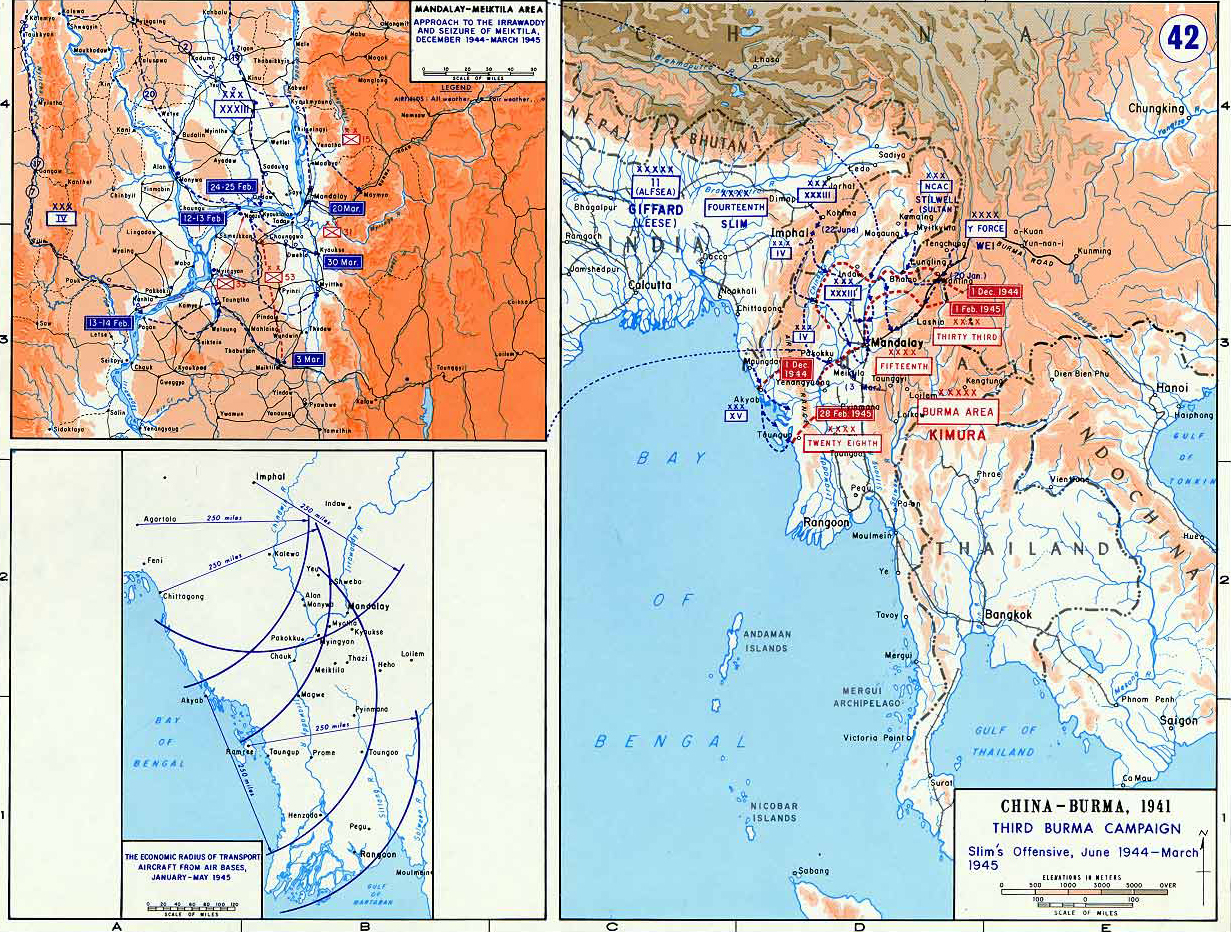Map Description
History Map of WWII: Burma Campaign 1944/45
The entire Burma Campaign was fought from 14 December 1941 - 13 September 1945, and was part of both World War II
and the Second Sino-Japanese War.
Illustrating:
Map ⓐ
Lieutenant General William Slim's Offensive June 1944 - March 1945
Lieutenant General William Slim’s offensive in Burma from June 1944 to March 1945 was marked by a masterful
application of maneuver warfare at the operational level, transforming the British Fourteenth Army from a
defensive force into a highly effective offensive army.
Slim’s strategy focused on outflanking and encircling
the Japanese, exploiting mobility and deception to stretch enemy supply lines and force withdrawals. He
orchestrated a series of coordinated advances, using flexible corps-level maneuvers and integrating improved
logistics and air support to sustain his forces in difficult terrain.
This approach enabled the Allies to regain the initiative following their defensive victory at Imphal and
Kohima — two decisive battles fought from March to July 1944 that repelled the Japanese Operation U-Go.
The defeat of Japanese forces in these battles marked the turning point in the Burma campaign and allowed
Slim to shift to a sustained and aggressive Allied offensive. His integration of air supply and operational
maneuver — particularly in harsh jungle and mountainous terrain — demonstrated a pioneering form of warfare
that emphasized flexibility, tempo, and strategic deception.
Map ⓑ
Mandalay-Meiktila Area
Approach to the Irrawaddy River and Seizure of Meiktila
December 1944 - March 1945
In the Mandalay–Meiktila campaign, Slim’s forces executed a bold and unexpected thrust across the Irrawaddy
River in early 1945, bypassing heavily defended Japanese positions to strike at Meiktila, a key logistical
and communications hub for the Japanese Burma Area Army. This maneuver was designed to disrupt Japanese command
and control and sever their main lines of supply and retreat.
The operation was spearheaded by the Indian IV Corps under Lieutenant General Frank Messervy and involved a
rapid, armor-supported advance by combined British and Indian infantry divisions. Supported heavily by air
supply and close air support, these forces captured Meiktila in early March 1945.
This victory was a devastating
strategic blow to the Japanese, forcing them to commit to a costly counteroffensive that ultimately failed. As a
result, the Japanese were compelled to retreat from Mandalay, which was taken by the Indian 19th Division in
mid-March after intense fighting.
The campaign demonstrated the effectiveness of operational surprise, deep penetration, and the integration of
combined arms and air support in modern warfare, and is often cited as a textbook case of achieving strategic
paralysis through rapid maneuver.
Map ⓒ
The Economic Radius of Transport Aircraft from Air Bases
January - May 1945
During the final stages of the Burma campaign, Allied strategy increasingly relied on the economic radius
of air transport — the maximum effective range within which aircraft could support frontline forces without
exhausting logistical capacity — to sustain rapid advances and maintain operational tempo.
Aircraft operating from newly captured and expanded air bases enabled the delivery of supplies, reinforcements,
and the evacuation of casualties far beyond the limits of traditional ground-based logistics.
This reliance on air mobility allowed Slim’s forces to leapfrog over difficult terrain, bypassing Japanese
strongpoints and supporting isolated columns deep in enemy-held territory. It also provided the flexibility
to maintain constant pressure on retreating Japanese forces and to redeploy troops efficiently in response
to evolving operational needs.
The use of RAF and USAAF transport aircraft — along with innovations such as air-dropped supplies and glider
insertions — extended the operational reach of the Allied advance into central and southern Burma, helping
to maintain the momentum that ultimately led to the reconquest of Rangoon by May 1945.
Credits
Courtesy of the United States Military Academy Department of History.
Related Links
Map of the Burma Campaign 1943/44Map of the Burma Campaign: Allied Victory, April - May 1945
About World War II
WWII Timelines
About the Second Sino-Japanese War

